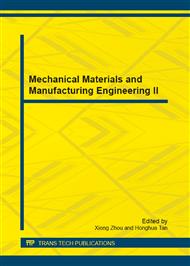[1]
B. S. Kerner, Empirical macroscopic features of spatial-temporal traffic patterns at highway bottlenecks, Phys. Rev. E. 65(2002) 046138.
DOI: 10.1103/physreve.65.046138
Google Scholar
[2]
R. Jiang, Q. S. Wu, and B. H. Wang, Cellular automata model simulating traffic interactions between on-ramp and main road, Phys. Rev. E. 66(2002) 036104.
DOI: 10.1103/physreve.66.036104
Google Scholar
[3]
R. Jiang, B. Jia, Q. S. Wu, The stochastic randomization effect in the on-ramp system: single-lane main road and two-lane main road situations, J. Phys. A. 36(2003) 11713-11723.
DOI: 10.1088/0305-4470/36/47/001
Google Scholar
[4]
R. Jiang and Q. S. Wu, Phase transition at an on-ramp in the Nagel–Schreckenberg traffic flow model, Physica A. 366(2006) 523-529.
DOI: 10.1016/j.physa.2005.10.026
Google Scholar
[5]
B. Jia, R. Jiang and Q. S. Wu, The effects of accelerating lane in the on-ramp system, Physica A. 345(2005) 218-226.
Google Scholar
[6]
E. Brockfeld, R. Barlovic, A. Schadschneider and M. Schreckenberg, Optimizing traffic lights in a cellular automaton model for city traffic, Phys. Rev. E. 64(2001) 056132.
DOI: 10.1103/physreve.64.056132
Google Scholar
[7]
X. B. Li, R. Jiang, Q.S. Wu, Cellular automaton model simulating traffic flow at an uncontrolled T-Shaped intersection, Int. J. Mod. Phys. B, 18(2004) 2703-2707.
DOI: 10.1142/s0217979204025944
Google Scholar
[8]
D.W. Huang and W.N. Huang, The influence of tollbooths on highway traffic, Physica A 312(2002) 597-608.
DOI: 10.1016/s0378-4371(02)00978-0
Google Scholar
[9]
R.Jiang, B. Jia, Q.S. Wu, The lane expansion effect of the tollbooth system on the highway, Int. J. Mod. Phys. C 15(2004) 619–628.
DOI: 10.1142/s0129183104006078
Google Scholar
[10]
X. M. Zhao, Z. Y. Gao and B. Jia, The capacity drop caused by the combined effect of the intersection and the bus stop in a CA model, Physica A. 385(2007) 645–658.
DOI: 10.1016/j.physa.2007.07.040
Google Scholar
[11]
X. M. Zhao, Z. Y. Gao and K. P. Li, The capacity of two neighbor intersections considering the influence of the bus stop, Physica A. 387(2008) 4649–4656.
DOI: 10.1016/j.physa.2008.03.011
Google Scholar
[12]
X. M. Zhao, G. C. Song, and Y. K. Song, Traffic congestion mechanism in two ramp systems, Commun. Theor. Phys. 55(2011) 95-99.
DOI: 10.1088/0253-6102/55/1/19
Google Scholar
[13]
F. Li, Z. Y. Gao and B. Jia, Traffic behavior in the on-ramp system with signal controlling, Physica A. 385(2007) 333-342.
DOI: 10.1016/j.physa.2007.06.021
Google Scholar
[14]
K. Nagel and M. Schreckenberg, A cellular automaton model for freeway traffic, J. Phys. I 2 (1992) 2221-2229.
DOI: 10.1051/jp1:1992277
Google Scholar


